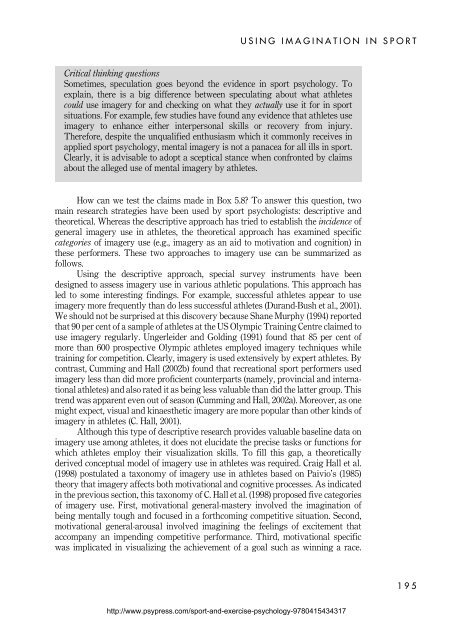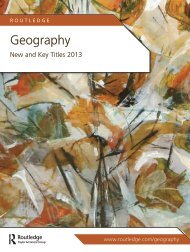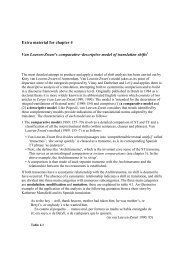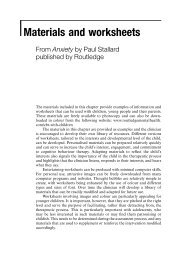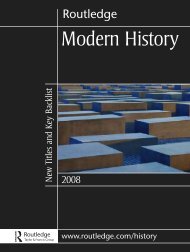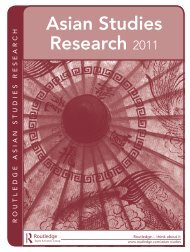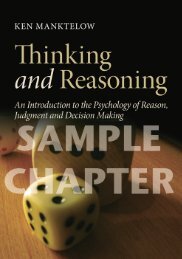Sport and Exercise Psychology: A Critical introduction ... - Routledge
Sport and Exercise Psychology: A Critical introduction ... - Routledge
Sport and Exercise Psychology: A Critical introduction ... - Routledge
Create successful ePaper yourself
Turn your PDF publications into a flip-book with our unique Google optimized e-Paper software.
USING IMAGINATION IN SPORT<br />
<strong>Critical</strong> thinking questions<br />
Sometimes, speculation goes beyond the evidence in sport psychology. To<br />
explain, there is a big difference between speculating about what athletes<br />
could use imagery for <strong>and</strong> checking on what they actually use it for in sport<br />
situations. For example, few studies have found any evidence that athletes use<br />
imagery to enhance either interpersonal skills or recovery from injury.<br />
Therefore, despite the unqualified enthusiasm which it commonly receives in<br />
applied sport psychology, mental imagery is not a panacea for all ills in sport.<br />
Clearly, it is advisable to adopt a sceptical stance when confronted by claims<br />
about the alleged use of mental imagery by athletes.<br />
How can we test the claims made in Box 5.8? To answer this question, two<br />
main research strategies have been used by sport psychologists: descriptive <strong>and</strong><br />
theoretical. Whereas the descriptive approach has tried to establish the incidence of<br />
general imagery use in athletes, the theoretical approach has examined specific<br />
categories of imagery use (e.g., imagery as an aid to motivation <strong>and</strong> cognition) in<br />
these performers. These two approaches to imagery use can be summarized as<br />
follows.<br />
Using the descriptive approach, special survey instruments have been<br />
designed to assess imagery use in various athletic populations. This approach has<br />
led to some interesting findings. For example, successful athletes appear to use<br />
imagery more frequently than do less successful athletes (Dur<strong>and</strong>-Bush et al., 2001).<br />
We should not be surprised at this discovery because Shane Murphy (1994) reported<br />
that 90 per cent of a sample of athletes at the US Olympic Training Centre claimed to<br />
use imagery regularly. Ungerleider <strong>and</strong> Golding (1991) found that 85 per cent of<br />
more than 600 prospective Olympic athletes employed imagery techniques while<br />
training for competition. Clearly, imagery is used extensively by expert athletes. By<br />
contrast, Cumming <strong>and</strong> Hall (2002b) found that recreational sport performers used<br />
imagery less than did more proficient counterparts (namely, provincial <strong>and</strong> international<br />
athletes) <strong>and</strong> also rated it as being less valuable than did the latter group. This<br />
trend was apparent even out of season (Cumming <strong>and</strong> Hall, 2002a). Moreover, as one<br />
might expect, visual <strong>and</strong> kinaesthetic imagery are more popular than other kinds of<br />
imagery in athletes (C. Hall, 2001).<br />
Although this type of descriptive research provides valuable baseline data on<br />
imagery use among athletes, it does not elucidate the precise tasks or functions for<br />
which athletes employ their visualization skills. To fill this gap, a theoretically<br />
derived conceptual model of imagery use in athletes was required. Craig Hall et al.<br />
(1998) postulated a taxonomy of imagery use in athletes based on Paivio’s (1985)<br />
theory that imagery affects both motivational <strong>and</strong> cognitive processes. As indicated<br />
in the previous section, this taxonomy of C. Hall et al. (1998) proposed five categories<br />
of imagery use. First, motivational general-mastery involved the imagination of<br />
being mentally tough <strong>and</strong> focused in a forthcoming competitive situation. Second,<br />
motivational general-arousal involved imagining the feelings of excitement that<br />
accompany an impending competitive performance. Third, motivational specific<br />
was implicated in visualizing the achievement of a goal such as winning a race.<br />
http://www.psypress.com/sport-<strong>and</strong>-exercise-psychology-9780415434317<br />
195


